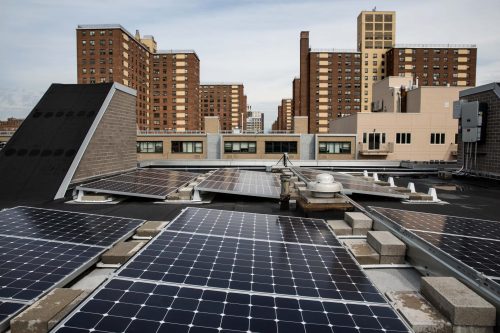Forecasters predict that the next few years will see strong growth in the microgrids market.
Microgrids are self-contained networks that have many of the features of a main electricity grid, such as generators, storage, and consumers, but on a much smaller scale. And, although they can connect to the main grid, they are not reliant on it.
Microgrids are not new, they have been around for decades. What is new, is that they are gaining popularity and appear to be moving from niche to mainstream.
 The falling costs of wind and solar energy capture is helping to drive the rise in microgrids.
The falling costs of wind and solar energy capture is helping to drive the rise in microgrids.
Image: pixabay-1989416.
This change appears to be the result of several factors.
Reliable and secure
One factor is the rising need for electricity that is reliable and secure, such as to power hospitals, gas distribution, water treatment, and other services where loss of power could risk lives or cause major disasters.
Organizations that need energy security and continuity for their operations are also attracted to the idea of locally-controlled, reliable, efficient, and economic electrical power. These include college campuses, research centres, data centres, and other high-tech industries.
Because of their self-contained nature, microgrids offer increased resilience and security – for instance against terrorist and cyber attacks – in ways that a centralized grid cannot.
Even from the point of view of the utility, it could be more economical to install a microgrid to serve a new cluster of customers rather than add another line from the main grid.
Behind some of these factors is the emergence of new technology that makes it easier to manage microgrids and their various components, and also of falling costs of solar and wind energy, which lend themselves to microgrid solutions.
Also, because they reduce the distance between energy production and energy consumption, removing the need for long-distance infrastructure, microgrids reduce energy loss and cut greenhouse gas emissions.
Growing market
Although their figures vary, against this backdrop, forecasters are saying the same thing: the microgrid market is taking off.
For example, a recent report suggests that the global microgrid market will grow at an annual rate of 17 percent to reach $18 billion between now and 2025, while another earlier report said it would grow at a rate of 12.5 percent from 2015 to reach in $39 billion 2022.
 The Marcus Garvey project in the Brooklyn-Queens area of New York City is an example of how microgrids are “transforming the energy supply chain.” Image: Demand Energy
The Marcus Garvey project in the Brooklyn-Queens area of New York City is an example of how microgrids are “transforming the energy supply chain.” Image: Demand Energy
Both reports cite different market sizes and examine slightly different periods, and use different definitions of microgrids – something that even the experts are not fully agreed on (see here for a couple of formal definitions).
The growth in microgrid markets is likely to take different forms in different parts of the world.
For instance, in Africa, where over 600 million people do not have access to electricity, there are opportunities to build microgrids “from the ground up” and leapfrog traditional centralized grid systems.
This can be seen in business models such as those being deployed in Kenya by microgrid company SteamaCo, who are installing pay-as-you go microgrids.
Meanwhile, in some islands off the cost of Africa, updates to existing microgrids are taking place to reduce dependence on fossil fuel by incorporating wind and solar power.
Transforming the energy supply chain
However, in North America, where a lot of the growth in the microgrid market is expected to happen, the focus is likely to be on microgrids that can be connected to the main grid, but offer communities greater self-reliance.
The Marcus Garvey Village microgrid in the Brooklyn-Queens area of New York City is a prime example.
The microgrid serves a social housing complex of 625 homes. Demand Energy, the company that built it, says it shows how a major city can “transform the energy supply chain,” by building “an intelligently controlled distributed digital power grid, provide local resiliency and other grid-supporting capabilities.”

